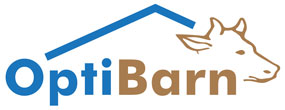Optibarn - Optimised animal specific barn climatisation facing temperature rise and increased climate variability
Background
Naturally ventilated buildings are particularly vulnerable to climate change since the indoor climate strongly depends on the extremes and variability of the outdoor climate. Without sound adaptation strategies, increased climate variability will result in a sub-optimal thermal environment in many livestock buildings impairing production and welfare of animals.
Appropriate construction methods and management of the buildings can improve the thermal control and provide precise identification of factors affecting the thermal control capacity of the buildings under commercial farm conditions.
Optimisation with regard to climate change
Optibarn aimed to develop region-specific, sustainable adaptation strategies for dairy housing. A special focus was on optimized climatisation of naturally ventilated buildings.
A team of scientists from seven research institutes in Germany, Denmark, Spain, Israel and Australia compiled possibilities to optimise barn climatisation. By consistently involving partners from the field, it was possible to incorporate the needs of the practice and disseminate the results to the target group.
Work steps
- Determination of the influence of outdoor climate on the indoor conditions of different naturally ventilated barns
- Implementation of a region-specific risk analysis of current and future weather extremes under consideration of different climate change scenarios
- Monitoring of individual animal stress responses to indoor conditions in different representative climate zones
- Development of engineering solutions to control the indoor climate
- Modelling tools for the assessment of the ecological and economic effects of the forms of adaptation



